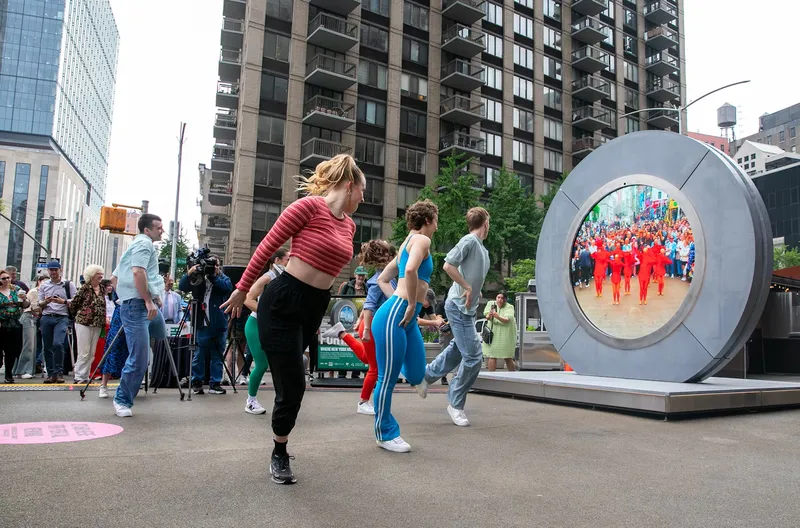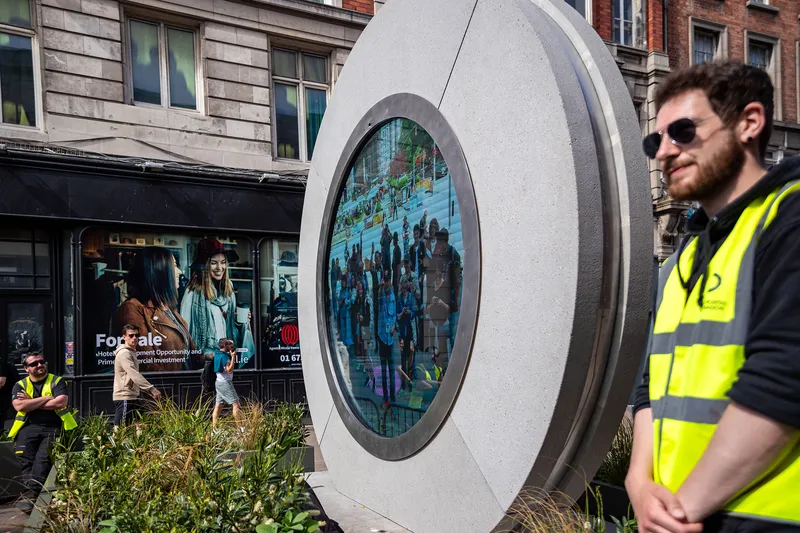From NYC to Dublin, this Portal brings people together
In a world of increasingly polarising narratives, an interactive art installation creates a visual bridge between New York and Dublin and aims to transcend geographical boundaries.
In sci-fi fiction and movies, opening a portal is always fraught with tension and a musical crescendo. But that wasn’t the idea when the Portal, a new interactive art installation, opened in New York City in May 2024, allowing people to communicate with those in Dublin, Ireland, 3,000 miles away.
The idea was simple—to let people of varied cultures and different cities meet beyond borders and above differences, via a real-time, unfiltered, 24/7 livestream. Be it saying hello with exaggerated waves or shaking a leg in tandem during a dance performance, the Portal offers a chance to connect beyond borders and cultures, to experience the world as “united and one”.
The brainchild of Lithuanian artist Benediktas Gylys, the Portal is a public sculpture that incorporates science and technology. But unlike its sci-fi counterpart, this Portal is more than just a technological or magical doorway that connects two distant locations separated by spacetime; it’s a piece of art that opens a window to distant locations, offering a new way to meet and experience our world as a united entity.
The first of these modern sculptures—linking Vilnius, Lithuania, to Lublin, Poland—was opened on May 26, 2021.
“The livestream provides a window between distant locations, allowing people to meet outside of their social circles and cultures, transcend geographical boundaries, and embrace the beauty of global interconnectedness,” Gylys said after the NYC-Dublin portal was opened.

Dance routines and cultural programmes livestreamed through the Portal help people connect across the Atlantic Ocean. Photo: Simons Foundation
The Portal creates an unprecedented visual bridge between New York and Dublin, via the 24/7 livestream and stands tall as a testament to the power of art to transcend physical barriers.
While the NYC Portal is located at Broadway, Fifth Avenue, and 23rd Street, next to the Flatiron Building, the Dublin Portal faces O’Connell Street, the main street in Ireland’s capital, and captures the iconic view of the GPO building and the Spire.
The New York City Portal has been made possible by the Flatiron Nomad Partnership, Simons Foundation, and New York City Department of Transportation’s Art Program while the Dublin Portal is supported by Dublin City Council.
As many as 500 million people visited the Portal in the first five days it was open. However, within a week of opening, the cameras were shut down, thanks to “inappropriate behaviour by a small minority of people”.
A woman spotted “slapping and grinding” against the sculpture was taken away by Dublin police; a rowdy group of Dubliners was spotted waving phones with images of the Twin Towers on 9/11; and OnlyFans model Ava Louise flashed some Irishmen passing by, asking, “Do you guys like my potatoes, Dublin?!” Thankfully, the Portals do not have audio and so the Irishmen couldn’t hear her!
Portals.org, the organisation that maintains the sculptures, says on its website that portals invite us to meet “above language barriers and connect using the only global language known to all humankind: body language”.
In an Instagram video, Gylys has stated that the most misunderstood thing about Portals that sometimes frustrates him is that it's “not about connecting just two countries…Portals are sculptures that form a global network that is going to act as a bridge to a united planet”.

Security has been increased at Portal, which was shut down for a week because of inappropriate behaviour | Image source: Shutterstock
Headed to the US for the T20 World Cup? Check out these family vacation spots
The Portal between New York City and Dublin—part of Gylys plan to bring the world closer—is scheduled to run through Fall 2024, with cultural performances and scheduled programming.
Later this month, these two Portals will also connect to the ones in Poland and Lithuania.
“Every minute. the connection rotates between multiple countries on Earth, inviting all of us to meet above borders and differences,” Gylys said in the video.
More than anything else, the sculpture is a way to open a window between places that are far away, to get a glimpse of its people and culture. Most people walking by just smile or wave, others make heart shapes with their hands or signal energetic high fives. A few even break out into an energetic dance performance—solo or flash mob like!
Despite the little fracas that led to a temporary halt in the livestream, the portal is a place of connection and coming together, with many old friends reuniting across the Atlantic.
A woman from NYC notched up almost one million views for a TikTok video that showed her meeting an Irish friend through the portal, each holding up heart signs. Another user on TikTok garnered four million likes for a simple video in which onlookers from both sides wave at each other.
A marriage proposal between the two portals was captured on a TikTok video, as was a couple’s marriage from across the Atlantic.
Last month, a collaboration of the Museum of Mathematics in Manhattan and Maths Week Ireland saw 10-year-old school children on both sides challenge each other to solve interesting puzzles.
Each Portal stands tall as an individual sculpture, but exists as one entity with the others. Much like the hive mind? Gylys has plans to create more portals, and the next set is likely to come up in London and Reykjavik, Iceland.
The Portal brings back childhood memories of looking into kaleidoscopes and peering into the neighbour’s window, of smiling goofily at a passer-by and making heart signs at a friend.
In a world of increasingly polarising narratives, this installation reveals that art can transcend geographical boundaries, that a window to another city is all we need to remember that “we humans have more to share than what separates us”.
Edited by Megha Reddy







